The biggest entertainment stories
Get our big stories about Hollywood, film, television, music, arts, culture and more right in your inbox as soon as they publish.
You may occasionally receive promotional content from the Los Angeles Times.
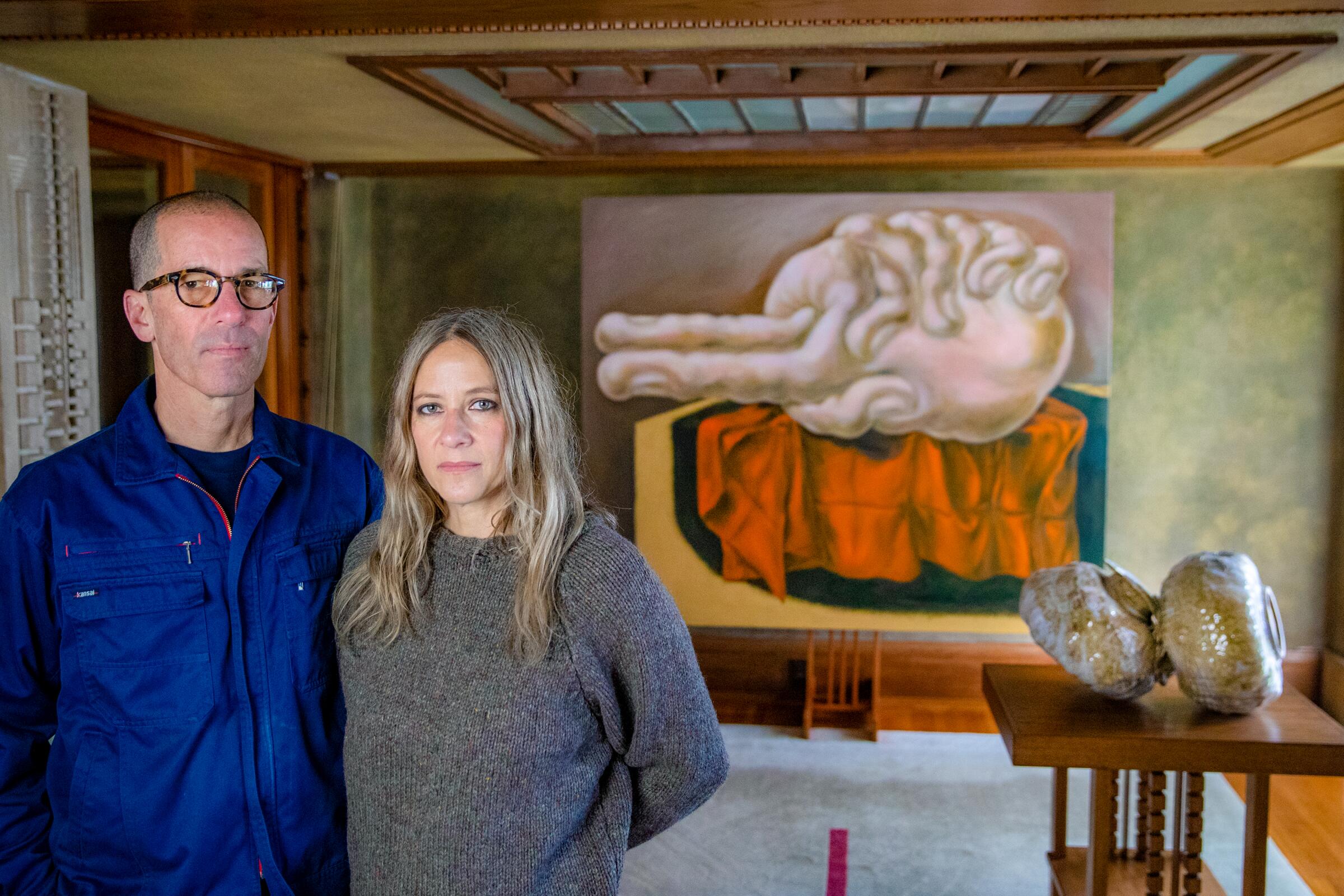
After the legal disputes between them were resolved, Aline Barnsdall — oil heiress, philanthropist and experimental theater producer — wrote to Frank Lloyd Wright, the architect of her home, a letter that includes these lines: “I hope we may not consider each other enemies and that we may never attempt to work together again. It can’t be done. We are both too much of the same mold — egotistical, dictatorial, and creative.”
Though the full scope of her commission — a 36-acre arts colony — was never realized, Barnsdall’s residence, the Hollyhock House, was Wright’s first major project in California. It is, in many ways, arguably the birthplace of California Modernism. Now a UNESCO World Heritage Site located within the municipal Barnsdall Art Park in East Hollywood, the house, its dynamic history and the complicated interactions between the visionaries who left their marks on it are explored in the exhibition “Entanglements: Louise Bonnet and Adam Silverman at Hollyhock House,” on view until June 24.
The show puts new works — two large paintings and a work on paper by Bonnet, and 11 ceramic vessels by Silverman — in dialogue with the house. “This isn’t a white box space by any means — Wright, by his nature, looms large and is a presence in the way he designs his spaces,” says Abbey Chamberlain Brach, curator at Hollyhock House and the organizer of the exhibition.
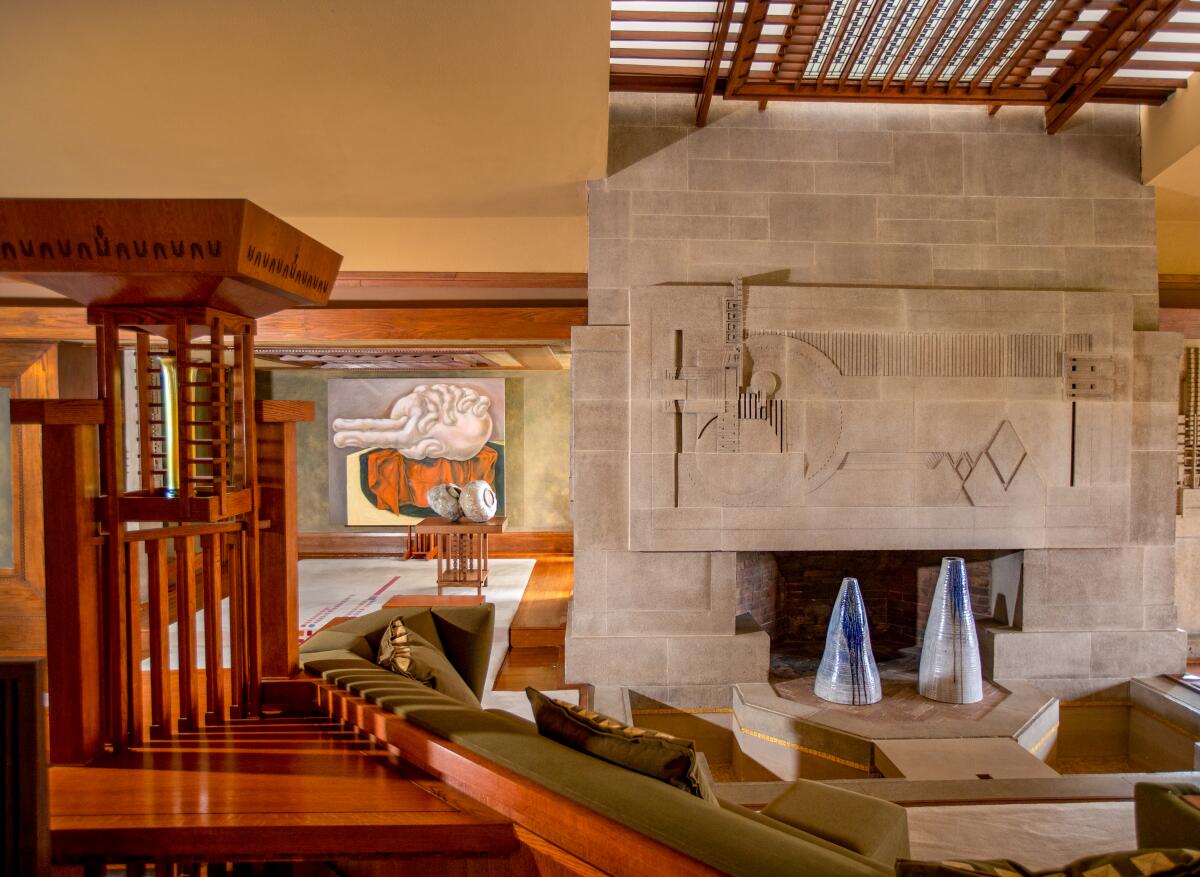
The way Wright’s ambitious design came into conflict with Barnsdall and other noted architects — including his apprentice Rudolph Schindler and Richard Neutra — who were enlisted to finish the house (long story short: Wright was fired) interested the artists enough that they proposed the show to Brach. “Wright brought Schindler here. They fought. Wright brought his son Lloyd Wright here — they had issues. … Then, of course, Barnsdall was raising her young daughter here too. There’s all of these connections of two people kind of succeeding and failing and fighting,” says Silverman.
Brach responded with an enthusiastic yes, even though the Hollyhock House hasn’t displayed contemporary art since becoming a museum in 1976. For Brach, the opportunity to have new art interpret the house harks back to Barnsdall’s desire that her home, which was originally envisioned to be part of a larger experimental arts colony, be an inspiration for art.
Something happened on a Hollywood hilltop as Friday the 13th turned into Valentine’s Day.
It also marks the first time Bonnet and Silverman, who are married and live in Silver Lake, have collaborated professionally. “We know that our work relates to each other, but it’s not obvious,” says Silverman. “What was interesting for us is the reality of relationships and the difficulty of relationships — and the fruit that comes from that can be positive and negative and both at the same time.”
In house museums like Hollyhock, artworks vie for attention with other parts of the domestic interior, such as furniture (here, much of it designed by Wright), views and even what books rest on a shelf. In their placement, Bonnet’s paintings and Silverman’s vessels highlight specific spots where tensions — sometimes layers of them — steep. Their artworks bring heated conversations between objects back into the room.
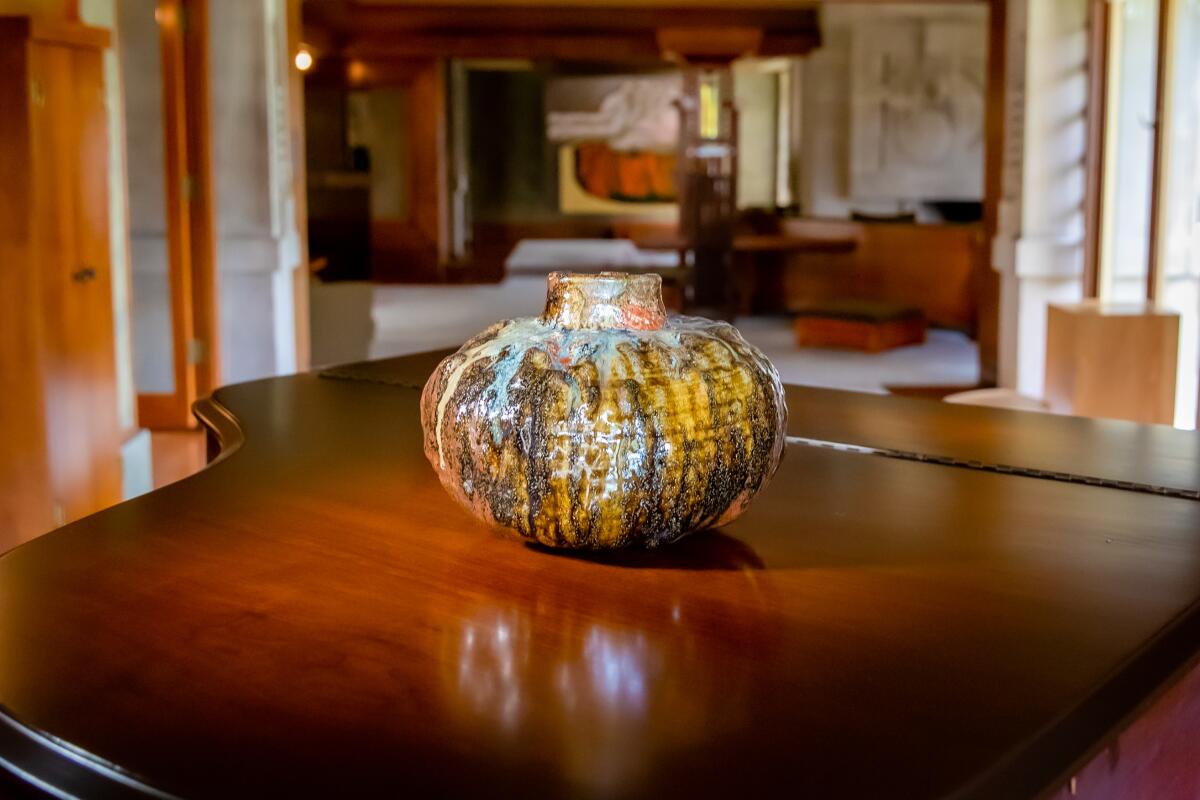
A boisterous example confronts visitors almost upon entry, in the long hallway known as the loggia. At the far end of the space, “Hollyhock Green,” a vibrant painting by Bonnet depicting a fistful of fingers clutching a hankie, responds to the Roman relief that is in front of it — a replica of a work Barnsdall installed in the room, much to Wright’s chagrin. The classical work had no place in his design, he said. So Barnsdall improvised, pushing two Wright-designed tables together to jury-rig a stand for it, asserting herself in the space. To the viewer’s right, and perched precariously close to the edge of a ledge, Silverman has placed a stoneware vase entitled “Dependents” that has a spherical appendage atop that seems likely to topple the piece over at any second.
The contemporary artists take different routes to spur this interdimensional conversation. Silverman, a former architect, infuses his ceramics with materials from the site — digging into the site by incorporating some of its raw materials. He uses olive ash in his glazes from trees on the grounds, which were once known as “Olive Hill.” Responding to Wright’s evocation of the four elements in the living room — and the room’s expansive view stretching to the Pacific — Silverman adds foraged clay, seaweed, salt, driftwood and shells to the glazes of his ceramics, two of which flank Wright’s famous concrete bas-relief hearth. Silverman’s towering vessels can’t fill the spaces of Wright’s outsized ambitions, including the empty moat that surrounds the architect’s masterpiece, a relic of a water feature that failed almost immediately after installation.
Bonnet intentionally placed her work into spaces where Barnsdall had displayed art from her own collection. “I was interested in having work where we knew she had work — placed exactly in the same place,” she says. She looked to the few archival photographs that exist from Barnsdall’s time living there — which wasn’t long. The house was completed in 1921; Barnsdall, a single mother frustrated at the upkeep the home required (that water feature!), gifted the property to the city in 1927. “I thought about domesticity a lot — Dutch still lifes, paintings that are a performative show of wealth and abundance on elegant tablecloths, Holbein portraits of people in their homes pretending to do work. I took that as a sort of structure and put these weights — pushing and pulling emotions — into the form that sits on top of it,” says Bonnet of how the site inspired her works for it.
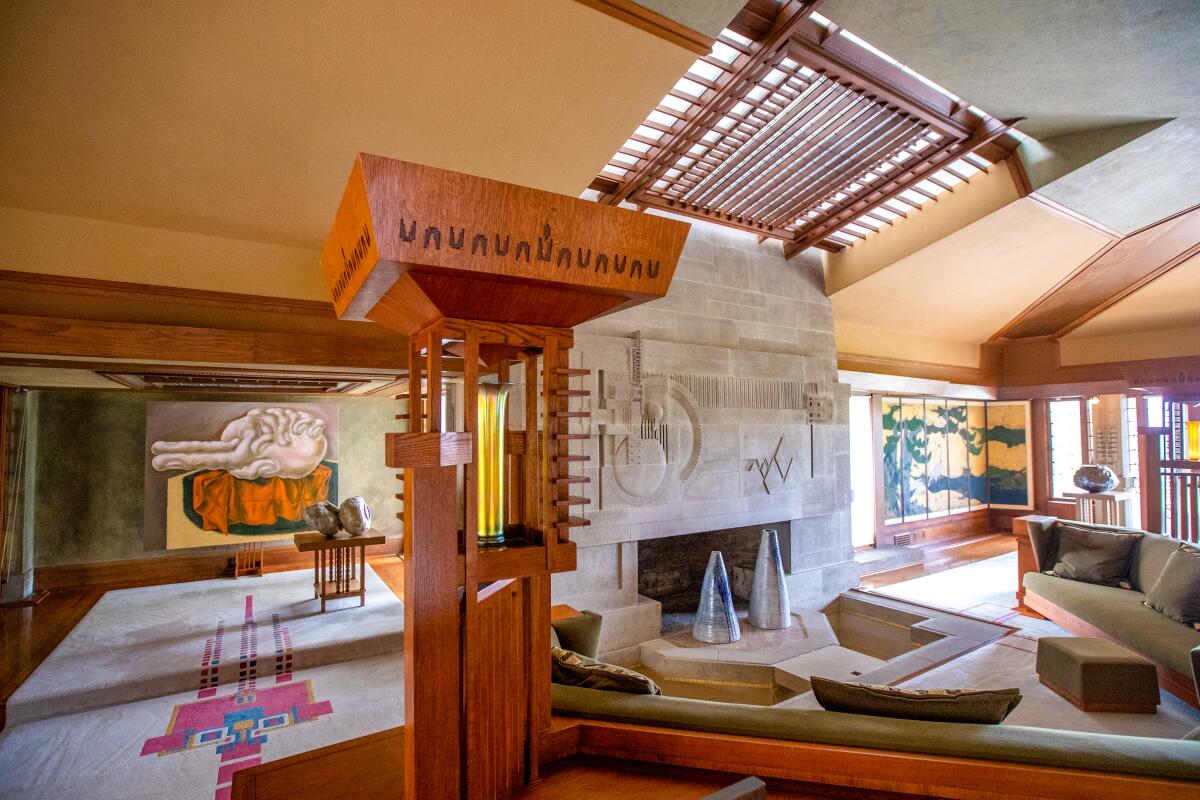
When the artists, who worked alone in their respective studios, brought their works together at the site, they were surprised to find “the house absorbed the work in a generous way,” as Bonnet puts it. She was particularly worried about the color of the walls in the alcove off the living room where she would install a “Hollyhock Gold,” a large painting of intertwined and elongated hands. During Barnsdall’s time, the nook held one of several Japanese screens purchased by Wright, who was largely absent during Hollyhock’s construction, working in Japan on the Imperial Hotel. Financially strapped, he started a side gig importing art and sold several screens to Barnsdall for her home. The two eventually ended up in court over the screens, among other things.
The weight and gravity of the figures in Bonnet’s paintings, “Hollyhock Green” and “Hollyhock Gold,” speak to the specific dynamics of the space, from the interpersonal relationships that locked horns here to Wright’s use of a design principle he called “compression and release,” where narrow passageways open into wide, spacious ones. Her works probe domestic tension, its constriction and release. Similarly, Silverman, who used a process called tumble stacking for several of his works where pieces are stacked on top of one another in the kiln, is interested in what compression within a small space can do. “The pieces melting together and merging into a new thing — losing their independence, in a way, and becoming fully dependent on one another and something completely different — like a relationship does to you,” he says.
Bonnet and Silverman’s intervention into this hallowed architectural monument posits that creation — even when artists are working alone — is rarely a single, solitary pursuit. It’s a relational act where multiple influences solidify into a new compound — the tumbling stacking of conversations, experiences, places.
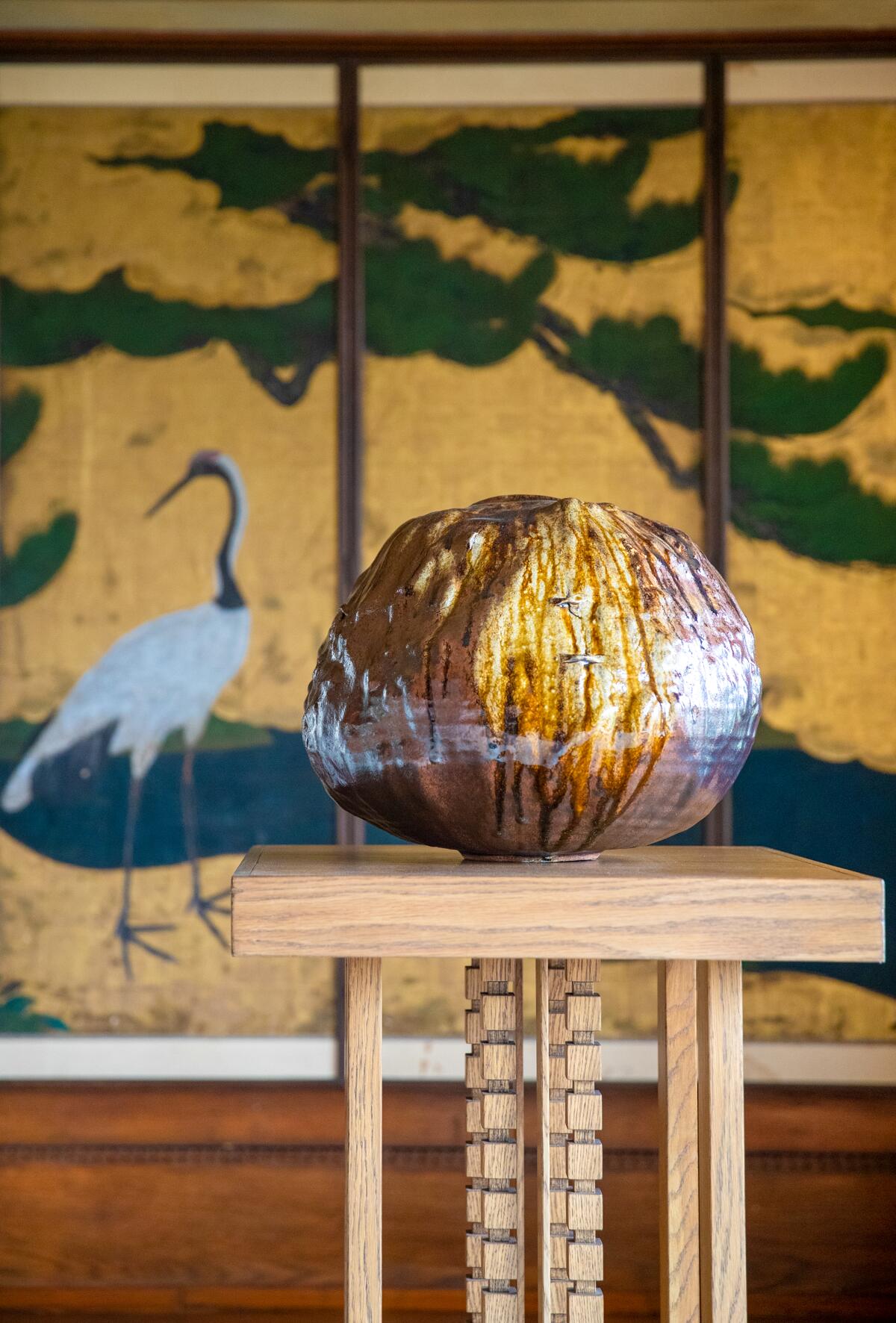
Humans make messes and masterpieces, and “Entanglements” posits that one is not possible without the other — or even that they are one and the same. Bonnet’s orange paint transforms the green wall behind it, and the walls of the room in turn take in the painting. It’s an unlikely embrace where discord creates its own beauty, disharmonious and true, where tension and conflict aren’t byproducts, but essential to art.
The fusing of the couple’s professional and personal lives became, according to Bonnet, “a bit claustrophobic.” Both artists admit they aren’t likely to do another joint exhibit anytime soon. Still, the couple credits the process of bringing their works together with pushing each artist into a new direction. And that’s case in point of entanglement as a generative force, creating its own kind of alchemy: “Doing [the show] here and doing it together changed the results,” says Silverman. “No question — had this been a gallery or a museum, the work would be different, even at the same point in our lives. And had I done this alone, or she done it alone, it would be completely different.”
'Entanglements: Louise Bonnet and Adam Silverman'
Where: Hollyhock House, Barnsdall Art Park, 4800 Hollywood Blvd., Los Angeles
When: Thursdays–Saturdays, 11 a.m.-4 p.m. Closed Sundays-Wednesdays. Through June 24
Tickets: $3-$7, advance reservations required. Purchase at hollyhockhouse.org
The biggest entertainment stories
Get our big stories about Hollywood, film, television, music, arts, culture and more right in your inbox as soon as they publish.
You may occasionally receive promotional content from the Los Angeles Times.